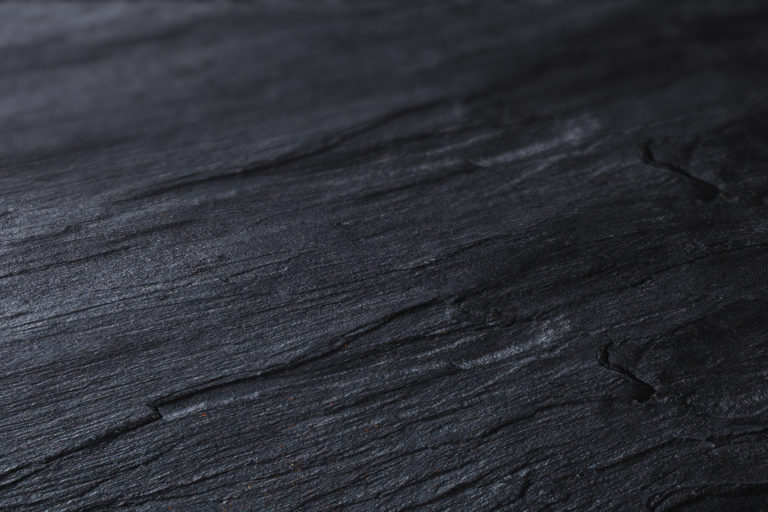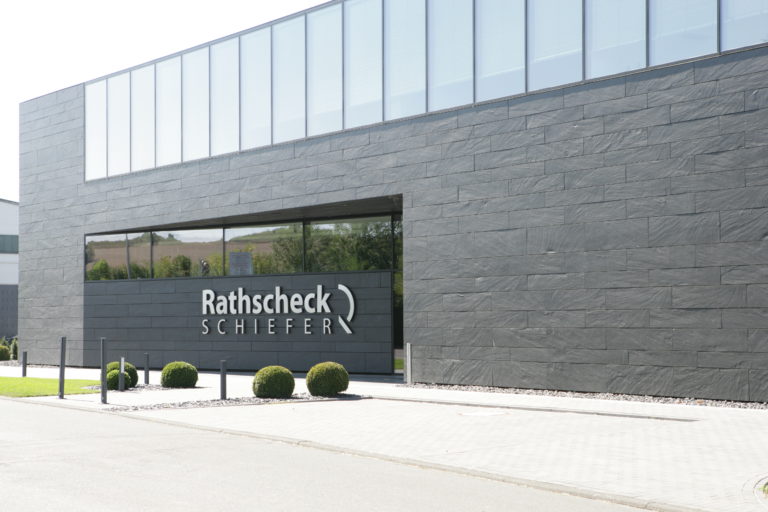FAQ
Frequently asked questions about slate.
MONUMENTUM®
The slate for excellent buildings.
With MONUMENTUM® we not only want to maintain a tradition, but also help shape the future. Our premium product continues the spirit of Moselschiefer®, which shaped the Old German covering for more than 200 years. Selected stones combine classicism with progress. MONUMENTUM® with its stone characteristics and variety of formats stands for the continuation of classic slate covering in sophisticated architecture.
With more than 40 years of experience with selected deposits and a quality system that far exceeds the national and European required test standards, Rathscheck continues the Old German covering with MONUMENTUM®. Through strict controls, careful selection and precise manufacturing, Monumentum® has the best test certificates in terms of water absorption and permeability, resistance to temperature changes and acid resistance. This means that every capstone that leaves the modern production facility in northwest Spain is a valuable unique specimen.
Moselschiefer®
Living beauty for highest demands.
Nature is a perfectionist. Moselschiefer® matured 400 million years deep underground and convinced with its natural character in highest quality.
Even the Romans appreciated the durability, luster and deep blue-gray color of this robust building material and quarried it here. Originally, the material was transported across the Moselle and thus received its name as early as 1588. Moselschiefer® is one of the oldest brand names in the world and still stands for slate of the best quality today.
For many generations, master builders and craftsmen have created buildings of lasting value with Moselschiefer® and perfected their craft to create Old German coverings - to this day, it is the queen among the cover types.
Today Moselschiefer® is used exclusively in gardening and landscaping. As decorative gravel in the form of slate chippings in various grain sizes, it is suitable for decorative surface design.
Because nature never goes out of fashion.
InterSIN®
A material with many facets.
InterSIN® is our trademark for blue-grey slate from international deposits. InterSIN® slate is mined underground and above ground with the greatest care and using the most modern technology.
Durability makes this robust and easy-care material an extremely economical material for roof and façade coverings. The blue-grey slate is a pure and high-quality natural product. Our Rathscheck quality system, developed from decades of experience, ensures a high quality standard of the individual slate deposits through compliance with the strictest criteria and constant on-site inspections. Slate samples are regularly subjected to numerous tests and must meet our requirements, which are based on the quality of our premium product MONUMENTUM®.
InterSIN® is available in many different capstone formats. From the economical universal covering, through the numerous covering types for façade cladding, to the scale covering, the right slate covering can be realized with InterSIN® for every taste and budget.
There are no limits to individual design possibilities. InterSIN® gives every object a unique character for generations.
ColorSIN®
Slate in the colors of nature.
What color is courage?
Slate. Living rock from nature. Formed millions of years ago by forces of nature. And still valued today as a building material with perfect properties for roofs and facades.
Everyone knows slate, the blue-grey, silky shining rock. But did you know that slate is also available in other colors?
Depending on the composition of the natural components, different color nuances of slate were created. This is why in some places on earth slate has red or green tones.
ColorSIN®, that is what we call our colored slate. The different cover types offer variety and colorful design possibilities. They give every slate covering an individual character.
ColorSIN®, just like the blue-grey slate, is a pure natural product and has the same properties. It is extremely durable, robust, easy to care for and surprisingly inexpensive. A colored slate covering always has a special aura.
Have courage. Show your color!
The stone quality of Classic is identical to our standard first quality and is therefore fully covered by our warranty with regard to the material. Only the criteria of the processing selection (selection) are different. Occasional missing holes, variations in gap thickness, slight bowls, bloated strips, thickening, slightly increased fracture and the like are possible, but these can usually be compensated for in roofing.
Therefore, Classic selections are offered at a lower price than the usual selections.
Old German style cladding, wild cladding, Schuppen (fish scale) cladding.
Bogenschnitt (curved cut) cladding, rectangular cladding, decorative cladding with Spitzwinkel (pointed angle), decorative cladding with Fischschuppen (fish scale), decorative cladding with Waben (honeycombs), decorative cladding with octogons, decorative cladding with coquettes and others.
More >> types of cladding
Durable colored slate in the shades of green, red, purple and red-brown is very rare in the world. The colors are natural, i.e. colored slate is marketed as it was extracted from the womb of the earth without any further artificial additives. With ColorSIN®, Rathscheck has succeeded in offering slate deposits with attractive natural colors. This opens up additional design possibilities for building owners, architects and planners.
Conditional on the fine-grained structure the slate colours are often dark (by high optical absorption e.g. blue-grey) or conditional on additional natural chromophore components, green (by the green mineral chlorite) or red to purple (by the mineral haematite).
Particularly in Thuringia and Saxony light slates can often be seen in old ornamental claddings; they are often called "white slate". This slate, however, obtained its light colour only in the course of time by continuous patination and ageing. Because if you split or break one of these white slates, you can clearly recognise its original light green colour.
In this respect, when restoring old ornamental claddings, light green slate, e.g. green ColorSIN® should be used in the preservation of historic monuments that is committed to the original condition.
We strictly separate and mark according to the exploitation sites, just like the technical rules of the ZVDH (Central Association of the Roofers\' Craft) demand. According to the technical rules slates from different exploitation sites may not be intermixed. Why? Slate is a product of nature. Formed in a long process in the earth\'s history. Not every deposit has the same geological conditions. Slate is a rock with natural differences in colour and different surface structures. When using slate from different exploitation sites, the roof or the façade would look spotted.
Slate is completely free of asbestos, it does not contain any asbestos nor any other mineral fibres.
No, roofing slate is not radioactive. The measured natural radioactivity existing everywhere is in slate even lower than in other rocks used for building purposes. In the former GDR, however, so-called "black slate" was exploited as uranium raw material. These slaty rocks, however, have nothing to do with roofing slate and they are also completely unsuited for the use on roof and façade.
No!
Basically all of them, although certain restrictions must be observed for individual formats:
In the case of the Altdeutsche Deckung and the Schuppen-Deckung the capstone height must not exceed 26 cm.
In addition, however, there are special types of cover and formats that are especially (and exclusively) suitable for use on the facade, such as the universal cover 20/20 cm as well as 25/25 cm, honeycomb 20/20 cm and special fish scales.
New, modern rectangular coverings have been developed especially for use on the facade, e.g. the Dynamic Coverage, the Underlaid Rectangular Coverage, the Variable Rectangular Coverage and the Linear Rectangular Coverage. Furthermore Rathscheck offers an innovative facade system, the Symmetrical Coverage. It is based on a slim substructure, the panels can be fixed visibly with clips or invisibly with undercut technology.
On the roof approx. 30-32 kg, on the facade approx. 28-30 kg, for special roofing with a sharp cut 36-38 kg and for double roofing 46-48 kg.
As from 22 degrees – here, however, a double cladding (old German style or rectangular) is required; all other types of cladding from 25 degrees onwards.
With a water-tight roof substructure it is, however, possible to stay below the regular pitch of the roof by 10 degrees.
No, one needs a classic roof structure, therefore solid shuttering. Pre-covering is required, at least V13.
In case of a rectangular cladding it is also possible to fasten the slate directly onto the lathing with the cramping technique.
As a rule with three slate-fixing pins or nails made of rustproof metal, that is hot galvanised (with a minimum coat of 50 my), made of copper or stainless steel (V2A).
On the façade the slates up to a cover slate of 24 cm can be fastened with 2 nails.
In addition, it is possible to also use cramp hooks and/or pointed hooks (V4A) for the rectangular cladding.
The texts for invitations for tender can be downloaded at the products, in the download sector or in the forums for architects and roofers.
There are a large number of roofing specialist dealers who stock Rathscheck slate. We will gladly name dealers in your area. Just send us a E-Mail
Rathscheck organises a number of different forums and symposiums specifically geared to the relevant target groups with regard to their type and extent.
Whether during the day of the roofer or the architect, the symposium of the specialist dealer or the slate or during the slate miners\' festival or the Mayen Roof Congress – here you will always learn something worth knowing all around slate – from the extraction via production and processing to laying and much more.
On account of many distinctive features provided by nature, slate is a matter for specialists. This requires a high degree of the buyer\'s confidence in his supplier which for this very reason can only be safely justified by proven specialists. Only vendors like Rathscheck Schiefer with experience over many years and an efficient control organisation for quality assurance on all levels of production and processing guarantee perfect slate in the end.
A natural product such as slate naturally has a good hand in an absolute comparison of all building materials. There are different opinions what is after all the most ecological building product. However, the State Institute for the Building Trade of the state of Northrhine-Westphalia, Aachen, in an overall assessment of outer walls reaches the conclusion: "Slate ... by far the lowest use of energy and lowest CO2 / SO2 emission values in the group under comparison" ... "no negative effects with regard to environment and health".
There are customers who report it to us. After their roof had been covered for the first time with the natural product Rathscheck Schiefer, they could for the first time again enjoy their night\'s sleep although in the time before they after all suffered very badly from electro smog. We are, however, unable to exactly explain the phenomenon. But the fact is interesting that slate indeed has electrical insulating properties, because in former times it was certainly customary to make electric switchboards from slate. Today such works of art could not be paid for any longer, quite in contrast to slate roofs where recently reasonably priced possibilities have become available.
Slate is a natural product that approximately 400 million years ago was formed from very fine-grained clayey mud. Approximately 325 million years ago came the transformation of these sediments into clayey slate. CFC-compounds are man-made and thus did not play any part in the natural history of the origin of slate. For this reason roofing slates cannot contain any CFC-compounds. The very low contents of carbon and possible ore compounds appearing instead of them are "natural" and give no cause for concern. During its entire service life slate has therefore exclusively properties that are friendly to health and environment.
Now and again spots of different colours appear in coloured slates. They do not represent any limitations of quality, but were formed naturally.
Thus it is absolutely possible that a green spot appears in a purple slate or a purple spot in a green slate. When it is small, it will hardly be noticed. This natural phenomenon is an indication for the fact that ColorSIN slates in the colours green as well as purple are related in their emergence and may appear together in a quarry.
This phenomenon is natural and no problem at all!
In view of the natural emergence of slate this should not be done. Particularly such colour variations are an indication for the natural product slate. At times excessive uniformity is an indication for industrial products. Change and precisely colour variations, on the other hand, are typical for the material of a natural product.


